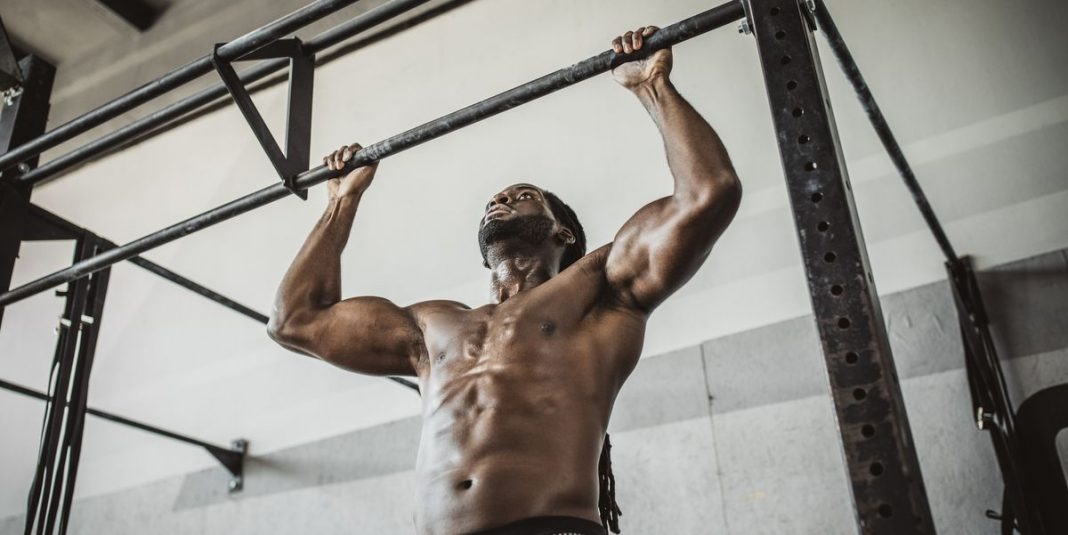The chinup and pullup should both be upper body exercise staples in your workout program. Both of these exercises target multiple muscle groups at once and are often considered milestone exercises, as in, they require a fair amount of upper body foundational strength to successfully complete.
Whether you’re a beginner or intermediate lifter, it’s a good idea to understand some of the key differences between the chinup and the pullup. Let’s break down some of the key elements of the movements, from which muscles are worked with each, common mistakes to avoid, and some of the best variations to use for a strong and dynamic upper body.
Men’s Health
The Main Differences Between a Chinup and Pullup
The fundamental difference between the chinup and pullup is your hand placement. For a chinup, your palm is facing your chin using an underhand (supinated) grip, and in the pullup, your palm is facing away from you in an overhand (pronated) grip.
An easy way to always remember their main difference is to think about scratching your chin. You scratch your chin with your palm facing you, so that’s a chinup.
Is the Chinup or Pullup Easier?
Generally, lifters will find that the chinup is easier than the pullup. The reasoning for this is that with higher biceps brachii activity, the shoulder-arm-forearm complex can be utilized slightly better than in the pullup.
Basically, lifters tend to have stronger biceps and lats when beginning their lifting journey—it feels more natural to vertically pull with a supinated grip.
Is the Chinup or Pullup Better for Hypertrophy?
The chinup and pullup are both fantastic exercises for upper body muscle building. Each exercise targets a variety of muscles and can be used to improve both arm, forearm, and back strength. It’s usually a good idea to program both in your workouts to make massive upper body gains.
This content is imported from {embed-name}. You may be able to find the same content in another format, or you may be able to find more information, at their web site.
Chinup vs. Pullup Muscles Worked

Westend61Getty Images
The chinup and pullup have a similar movement pattern, so the vast amount of muscles they work will have a high carryover between one another. Essentially, they’re going to work pretty much all of the same muscle groups, but the rate in which they work them will vary slightly based on your hand position and how the body produces strength through a vertical pulling movement pattern.
A helpful study that compared differences in muscle activation between the chinup and pullup comes from a paper that was published in 2010 in the Journal of Strength and Conditioning Research.
The authors noted that the primary muscles worked (in an activation descending order) between the chinup and pullup include:
- Lats
- Biceps Brachii
- Infraspinatus
- Lower Trapezius
- Pectoralis Major
- Erector Spinae
- External Oblique
The authors noted that the biceps brachii and pec major were more active during the chinup compared to the pullup, while the lower traps were more active in the pullup.
Another useful paper to look at for assessing muscles worked in the chinup and pullup comes from a study published in 2017 in the Journal of the International Society of Electrophysiological Kinesiology. Here, the authors compared four different hand positions used in common variations of the exercise: supinated, pronated, neutral, and wide grip.
The authors suggested that the pronated pullup (traditional) results in higher middle trapezius activation. They also pointed out the brachioradialis, biceps brachii, and pec major were all higher in the concentric (lifting) movement pattern compared to the eccentric (lowering) movement pattern.
When all four hand positions were compared, the authors also pointed out that muscle activation levels were all consistent when full reps were performed—however, specific muscle activation did vary slightly in the concentric and eccentric movement patterns. This is useful to know for lifters that program tempo focused chinup and pullup variations.
Chinup and Pullup Benefits

Eugenio MarongiuGetty Images
Both of these exercises will each have their own respective list of specific benefits that can be catered towards specific sports and other exercises. However, since they both similar in nature, there are a few benefits that overlap that are worth pointing out.
1. Milestone Exercise
A milestone exercise is a movement that requires a considerable amount of baseline strength in order to be performed. This is why it’s a tough exercise for a lot of beginners to accomplish right away.
Both the chinup and pullup are fantastic exercises to gauge upper body strength for beginners, intermediate, and advanced lifters. Beginners can use these exercises as assessment and to track their progress as they begin a dedicated training routine, while intermediate and advanced lifters can use them to assess their overall level of strength and fitness.
2. Minimal Equipment
If you have minimal equipment or you’re doing home workouts, the chinup and pullup are awesome for providing you with a lot of bang for your buck while needing very little equipment. Since they’re already fairly tough exercises to perform, you can progress regularly with each without breaking the bank buying equipment.
3. Carryover to Barbell Exercises and Sports
The chinup and pullup are vertical pulling exercises and target handfuls of upper body muscles. By strengthening the shoulder-arm-forearm complex, you’ll experience carryover to barbell lifts and sports. Whether you’re deadlifting or playing sports, you can’t go wrong with a stronger back and grip.
Common Chinup and Pullup Mistakes

cirkogluGetty Images
Since the chinup and pullup have higher bars of entry than most exercises, there are a few common mistakes beginners make when strength and form are lacking.
1. Swaying Too Much
If your goal is performing strict chinup and pullups, then you need to focus on your full body tension throughout the movement. You’ll often see athletes swaying around during the eccentric portion, which usually suggests lack of upper body stabilizer strength and form cognizance.
When performing chinups and pullups, try to keep a light level of engagement throughout the body and limit how much you’re swaying. The stricter you are, the better your vertical pull line will be and your movement competency will improve.
2. Gripping Too Close and Too Wide Without Intent
Grip width can also be an area that lifters get wrong with the traditional chinup and pullup. Poor grip width cognizance can lead to lacking mechanics and underutilization of prime movers (a.k.a. the muscles doing the majority of the work) in each lift.
There’s a time and place for close and wide grip chinup and pullup variations—which we’ll cover below—but for traditional chinups and pullups aim to perfect the grip width recommendations below.
Chinup: Roughly shoulder width apart.
At the top, if your hands are in-line with your shoulders, then you likely have a solid grip width. We want to fully utilize the arm flexors. For example, this is why we don’t perform wide-gripped barbell curls—we don’t want to limit our arm flexor’s ability to contract.
Pullup: Shoulder width or wider.
There’s a time and place for wide gripped pullups, but for most lifters a grip width that’s just outside of the shoulders will fair best for gains, mechanical proficiency, and strong, intent-driven contractions.
Best Chinup and Pullup Variations
Once you’ve conquered the chinup and pullup, you can start performing more variations catered to specific strength goals. Below are 14 fantastic chinup and pullup variations that can be used to boost your strength, power, and muscle.
Author’s Note: All of the variations below will have carryover for each of the goals listed below. In an effort to truncate variations for specific adaptations, we provided mini lists bucketing each variation!
Chinup and Pullup Variations for Grip
- Hockey Grip Pullup
- Mixed Grip Pullup
- Towel Pullup
- Close-Grip Chinup
Chinup and Pullup Variations for Form Improvement
- Eccentric Pullup
- Jumping Chinup
Chinup and Pullup Variations for Core Development
- L-Pull
- Crossover Pullup
Chinup and Pullup Variations for Lats and Upper Back
- Lateral Slide Pullups
- Plyo Pullup
- Wide Grip Pullup
Jake Boly, C.S.C.S.
Jake Boly, MS CSCS, is the Co-Founder of Pheasyque Lab, and works as a consultant for other fitness professionals trying to build websites and brands.
This content is created and maintained by a third party, and imported onto this page to help users provide their email addresses. You may be able to find more information about this and similar content at piano.io





